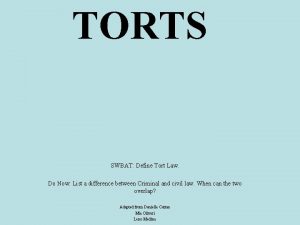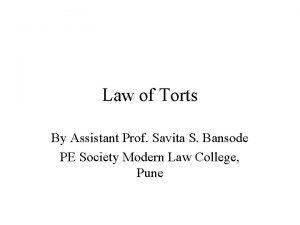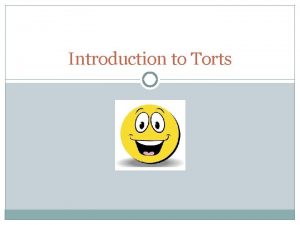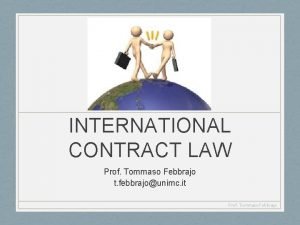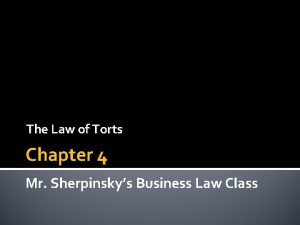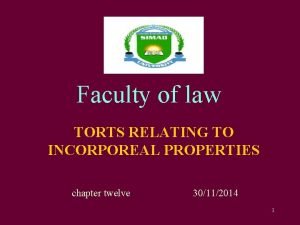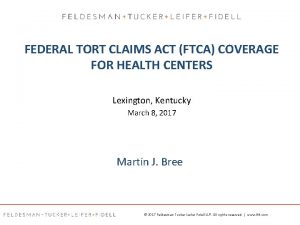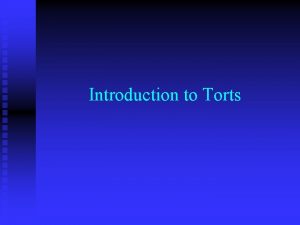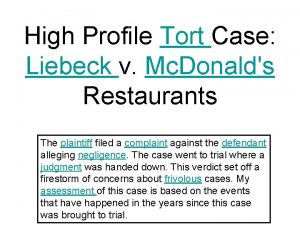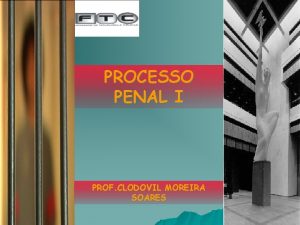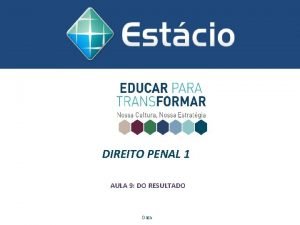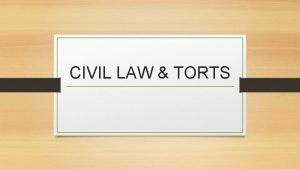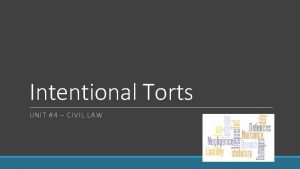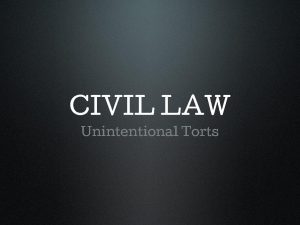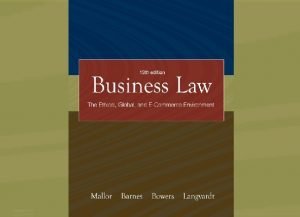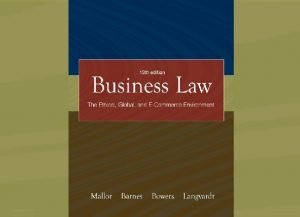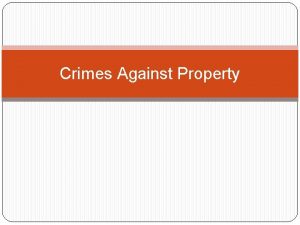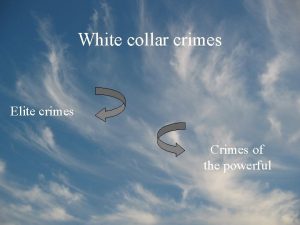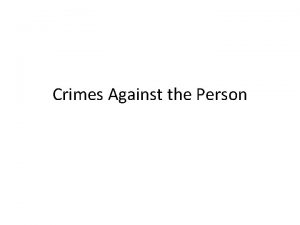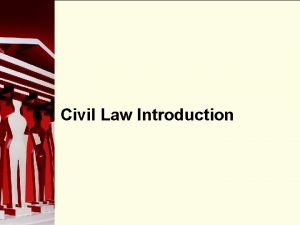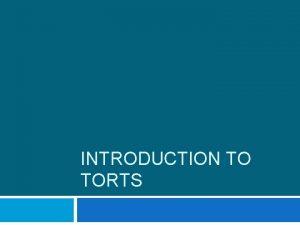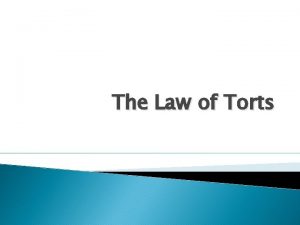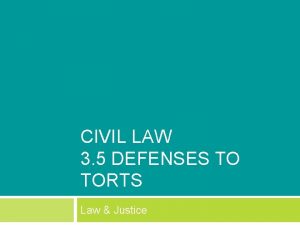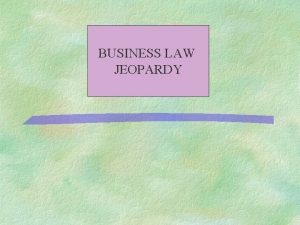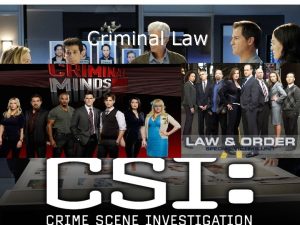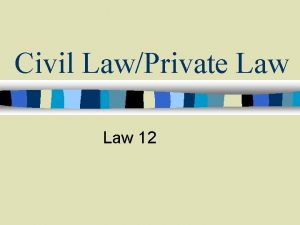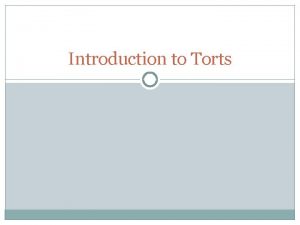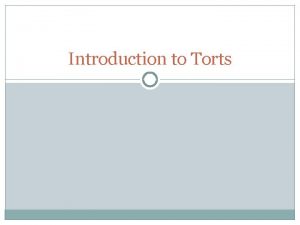INTRODUCTION TO TORTS CIVIL LAW CRIMES VS TORTS





















- Slides: 21

INTRODUCTION TO TORTS: CIVIL LAW

CRIMES VS. TORTS • A crime is a “public” wrong committed against society (in addition to the specific victim) • A tort is a “private” wrong committed against an individual • The same conduct can be both a tort and a crime

DEFINITION OF A TORT • A wrongful act that unfairly causes someone else to suffer loss or harm.

KEY DIFFERENCES • In what ways are torts different from crimes? • Parties • Burden of Proof • Remedies • What is the most common remedy in a tort case?

TWO KEY QUESTIONS • Tort law is designed to answer two critical questions: • Who is liable for harm caused by the activity in question? • How much should the liable person have to pay? (damages) • What are the goals of awarding damages? • Compensation • Deterrence • In some cases, punishment

ROTATING ACTIVITY • Assume that a civil suit is brought by the injured person in each of cases. • 1. Identify the plaintiff and the defendant(s) in each case • 2. Determine if the defendant should pay for the plaintiff’s damages.

THREE CLASSES OF TORTS • Intentional tort—i. e. assault • Example 1: Ben gets mad at Bart and punches him in the nose.

THREE CLASSES OF TORTS • Negligent tort--negligence • Example 2: Mary carelessly runs a red light and hits Tim’s car, damaging both the car and Tim.

THREE CLASSES OF TORTS • Strict liability tort—unreasonably dangerous actions • Example 3: Joe owns a tiger rehabilitation center and a tiger gets loose and kills 3 people

INTENTIONAL TORTS -Torts that injure persons -Torts that injure property

INTENTIONAL TORTS—INJURY TO PERSONS • Battery—intentional harmful or offensive contact (touching) • Infliction of emotional distress—words or actions intended to cause extreme anxiety or emotional distress • Conduct must be outrageous • Assault—action that puts another person in fear of an immediate harmful or offensive contact • Actual contact is not required

INTENTIONAL TORTS—INJURY TO PERSONS • Defamation—oral (slander) or written (libel) statements that are false, and which harm a person’s reputation • Must be a statement of fact, not opinion • “Public figures” must prove actual malice (intent to harm, not just intent to say something)

INTENTIONAL TORTS—INJURY TO PROPERTY • Real property—land/real estate • Trespassing • Nuisance (interfering with ability to enjoy one’s property • Personal property—things that can be moved • Intellectual property—inventions and creative works • All are protected in our system!

DAMAGES IN INTENTIONAL TORT CASES • Compensatory—damages that compensate the plaintiff for harm caused by the defendant • Examples? • Lost wages, medical bills, “pain and suffering, ” loss of consortium • Nominal—a small or “token” amount of damages awarded as a symbol of wrongdoing • Punitive—damages to punish the person committing the intentional tort

NEGLIGENCE A very broad term: the failure to exercise a reasonable amount of care in either doing or not doing something, resulting in the harm or injury of another person.

FOUR ELEMENTS • Duty—defendant owes a duty of care to the plaintiff (judge decides)—a legal obligation • i. e. lifeguard has a duty to save someone who is drowning, but a stranger passing by may not • Breach of duty—defendant’s conduct violated that duty (jury decides) • Causation—the defendant’s conduct legally caused the plaintiff’s injuries/harm • Damages—plaintiff suffered actual injuries or losses

BREACH OF DUTY—THE “REASONABLE PERSON” STANDARD • Negligence cases are decided based on whether a person’s conduct conforms to that of “the reasonable person of ordinary prudence or carefulness”

DAMAGES • Goal—restore the plaintiff to pre-injury condition (to extent possible) • Money is the primary remedy • Examples of damages: • Hospital and medical bills • Lost wages (past) • Lost future earnings • Property damage • Pain and suffering • Emotional distress • Mental/physical disabilities

WHAT IS STRICT LIABILITY? • Strict liability= liability without fault • Elements: • Causation (have to prove it is a unreasonably dangerous activity to which SL is applied) • Damages • Does not require proof of duty owed nor breach of duty, as required in negligence cases

THREE TYPES OF ACTIVITIES • Strict liability applies to: • Dangerous (“ultra hazardous”) activities—an activity where risk cannot be eliminated even by reasonable care • (1) wild animals kept as pets; and (2) domesticated animals whose tendency to bite is known • Defective (“unreasonably dangerous”) products

ROTATING ACTIVITY Revisit our civil cases and decide what type of tort is involved: • Intentional tort • Negligence • Strict liability tort
 What is tort law
What is tort law Law of torts
Law of torts Chapter 9 crimes against the person
Chapter 9 crimes against the person What is a civil law
What is a civil law Difference between civil law and criminal law
Difference between civil law and criminal law Common law and civil law
Common law and civil law Examples of civil law
Examples of civil law Common law and civil law
Common law and civil law Civil rights and civil liberties webquest
Civil rights and civil liberties webquest Types of torts in healthcare
Types of torts in healthcare Unintentional tort examples
Unintentional tort examples Example of incorporeal property
Example of incorporeal property Ftca gap coverage
Ftca gap coverage Torts class
Torts class Torts case
Torts case Newton's first law and second law and third law
Newton's first law and second law and third law Newton's first law
Newton's first law Boyle's law charles law avogadro's law
Boyle's law charles law avogadro's law P=k/v
P=k/v Theories of prejudice sociology
Theories of prejudice sociology Crimes habituais
Crimes habituais Crime impossivel
Crime impossivel
